A Collector’s Garden
where hostaholics and deer draw a tentative truce

Design credits:
home of Mike and Anita Sheehan
designed by Mike and Anita Sheehan
It seems impossible. How can six hundred juicy hostas and almost three hundred daylilies be ignored by the deer that pass this garden every day? Self-confessed plant addicts Mike and Anita Sheehan have had over forty years to fine-tune their tactics, but then again, the deer weren’t always a problem.
When the Sheehans purchased this rural acre in 1971, there were very few deer in this corner of Holland, New York, a quiet town in the foothills of the Allegheny Mountains where dairy farms pepper the pastoral scene. There was also very little house: the builder had run out of money, and they had to knock on their new neighbor’s door that first night to ask to use their bathroom, since theirs was far from complete. Once the house was finished, Mike and Anita turned their attention to the garden. When asked about their master plan for the landscape at that point, they both laugh. “There wasn’t one!” says Anita, who Mike concedes is the primary gardener, especially in those early years.

A barn quilt featuring stylized hosta leaves is a fitting emblem to adorn the Sheehans’ home. It is one of several in the area, part of a barn quilt trail to mark the 2018 bicentennial celebrations in Aurora, Wales, and Holland, New York.
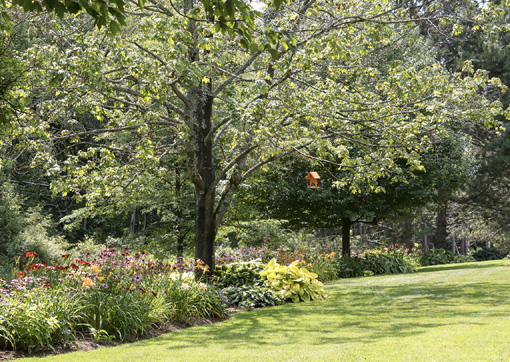
Although open to passing deer, this 150-foot-long border showcasing some of the Sheehans’ hosta and daylily (Hemerocallis) collections, as well as more typically deer-resistant coneflowers (Echinacea) and lungworts (Pulmonaria), not only survives but thrives thanks to their attentive regime.
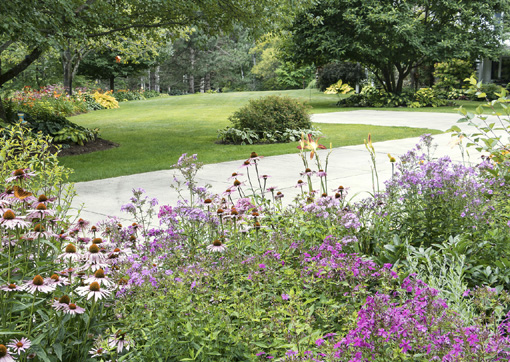
An open area of lawn was important for neighborhood badminton games, initially between the parents of toddlers, later for the growing children.
They began with the trees. A local nurseryman advised them to site a tree near the front patio to offer summer shade, so they planted a silver birch (Betula pendula), a tree Anita remembers fondly from her childhood. The saucer magnolia (Magnolia ×soulangeana) near the front door was a similarly sentimental choice, although sadly it often loses its flower buds to late frosts. Indeed, all plants have to be tough in this snowbelt, where temperatures plummet to minus 20°F and a deep blanket of snow can be expected every winter. Many conifers are good candidates for such situations, however, so when the county offered pine (Pinus) and spruce (Picea) saplings at a bargain-basement price as part of a reforestation program, they stocked up and planted them atop a berm to provide screening from the road, not knowing then that they would eventually anchor an extensive display garden. Anita explains how yesteryear’s trees evolved into today’s borders: “We dug a small circle to plant a tree. When the tree grew, we widened the circle—and filled it with plants. We just kept planting more trees, and over time those tree circles joined together.” When some of the pines declined, the Sheehans replaced them with silver maples (Acer saccharinum) for additional fall color.
Local gardening consultant Sally Cunningham had a more strategic approach to designing the foundation beds. “She arrived one day with a carload of plants—and her ninety-year-old mother,” Anita marvels. “Together we kept moving those plants around until we all liked it.” In the back garden, a border known as “the grotto” was dug by their son almost thirty-five years ago, primarily to offer a view from the back patio. Anita promised him at the time that she wouldn’t make any more beds. “I haven’t!” she exclaims with a twinkle in her eye. “I just expanded the ones I already had!”
The driveway bed is a case in point. Mike points out that it’s much more fun than a mowing strip and was a necessity to house all the new hostas and multi-hued daylilies they kept acquiring. Unfortunately, their love affair with these two collectible perennials coincided with an increase in the local deer population. Mike reports that they typically see three deer at a time, but it is not unusual to have eight or nine come through the garden together. With thirty-five acres of woodland behind them and another ten to one side, all interconnected by a series of trails, the deer have easy access onto and through the Sheehans’ property. Fencing is cost prohibitive, and since deer consider both hostas and daylilies pure caviar, the Sheehans had a significant but not insurmountable problem. They thwart the deer with a three-pronged approach:
• They plant in vast quantities, so minor damage is barely noticeable.
• They fertilize with Milorganite, which has well-documented (if anecdotal) deer repellent properties.
• They spray regularly with Mike’s special home-brewed repellent, alternated with Bobbex, a commercial spray.

The foundation beds are anchored by a towering, multi-trunked silver birch (Betula pendula), the first tree planted on the property. Later additions include a smokebush (Cotinus coggygria ‘Golden Spirit’) and an assortment of green and gold hostas.
Both sprays smell for a few hours, but they will not harm or discolor the plants, and they remain effective for approximately three weeks, unless there is a heavy rain, in which case Mike resprays. It takes him just one hour to spray four gallons of his concoction onto susceptible plants.
The Sheehans faced other gardening challenges. Their clay soil was a saturated quagmire during the rainy season, and heavy summer downpours swiftly turned prepared beds into small-scale Erie Canals. The slope into which the home and garden are set presented additional trials. Until they installed a series of drains to divert the runoff, their basement flooded every winter, and any mulch they added was washed away by heavy rain. Anita somersaulted down the hill twice and broke her ankle on another occasion, after impulsively heading up to cut a boutonnière while wearing dress shoes; she now uses garden tools to anchor herself and prefers to work from a kneeling rather than standing position for better balance and safety. Yet despite their advancing years, this spirited couple manage the garden without outside help, even to cutting back perennials in fall or spreading compost during planting time. “It’s the gardening that’s keeps us healthy,” says Anita.

The steep slope presents several challenges, including soil erosion.
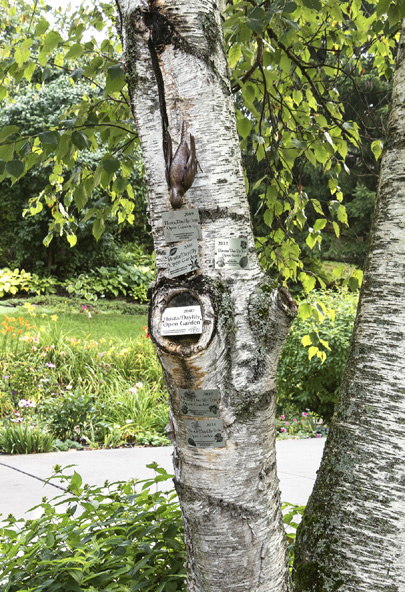
Anita’s birch commemorates some of the events they have hosted in their garden.
As passionate about people as they are about plants, it wasn’t long before Mike and Anita joined the local hosta and daylily societies. Both the Sheehans have served on the board of directors of the Western New York Hosta Society and have hosted everything from society teas to garden tours as part of the Gardens Buffalo Niagara program. They love the social aspect of these groups as much as the learning opportunities they afford and smile broadly as they talk about the many friends they have made through these organizations.
The American Hosta Society has named the hosta the “friendship plant,” a title Mike and Anita clearly embrace, generously sharing their treasures as well as gratefully receiving gifts of plants from others. Indeed, that’s how Anita first came to gardening, when after admiring something in a nearby garden the neighbor immediately reached for the shovel and dug out a clump to share. That’s what friendship is all about, as far as this big-hearted couple is concerned. Sharing themselves, their passion, and their plants. What a wonderful way to live a life.
Playing with Color and Texture
Artistic intuition has guided the Sheehans, and they have learned, by trial and error, a few tricks to keep their ever-expanding plant collections from morphing into a mixed bag of horticultural jelly beans. Looking for specific color echoes between plants suggests a sense of belonging; combining a yellow daylily with a yellow grass, for example, can enhance both. And it’s easy to create a sophisticated vignette by grouping different hostas; simply use solid colors or plants that are lightly patterned to set off more flamboyant specimens, just as you might use a wide, dark belt to separate a striped skirt from a polka dot blouse.
Flowering plants are magnificent when in bloom but can be a dreary mélange of green leaves the rest of the time. Daylilies and many flowering shrubs are examples of exactly that problem, but the Sheehans have a solution. They have underplanted their hedge of lilacs, flowering quince (Chaenomeles speciosa), and mock orange (Philadelphus), all of which look stunning in early spring, with an assortment of hostas, whose bold, brightly colored leaves add sparkle and disguise the base of these tall shrubs. In front of the hostas is a small strip of lawn before a bed of summer-blooming perennials has its moment in the spotlight. This tiered effect may be likened to a piece of framed art, the daylilies being the watercolor masterpiece, bordered by a green mat (the lawn) and accented with a colorful fillet (the hostas), before a solid frame (the shrubs) defines the limitations of the scene.
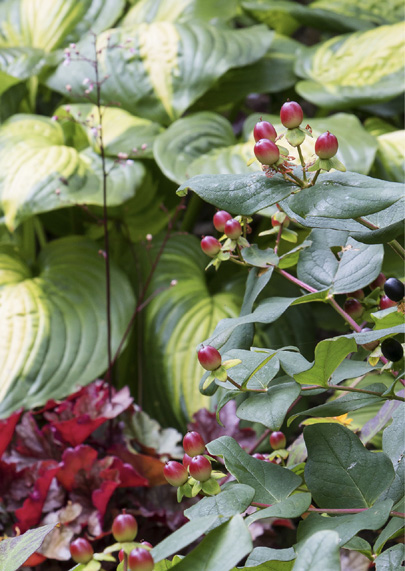
Here a variegated Hosta ‘Captain Kirk’ shines a spotlight on darker notes, a color echo between the ripening berries of St. John’s wort (Hypericum) and richly hued coral bells (Heuchera ‘Peach Flambé’).
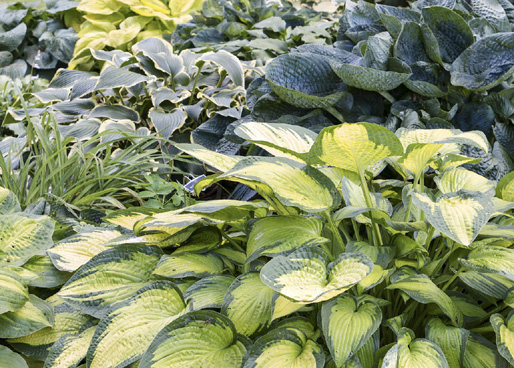
Blue is the theme that unites these hostas so effectively. Variegated Hosta ‘Paul’s Glory’ dominates the foreground, benefiting from the backdrop of a solid blue H. ‘Big Daddy’, with its tightly quilted, cupped leaves.
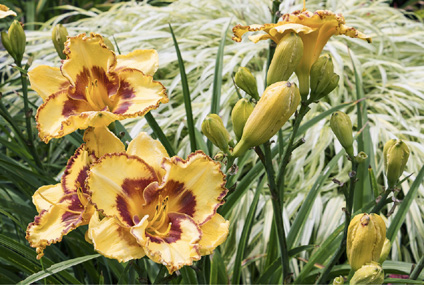
A lightly ruffled reblooming daylily (Hemerocallis ‘James Dean’) looks fabulous next to golden Japanese forest grass (Hakonechloa macra ‘Aureola’). In fall, this grass often has deep red threads running through the blades, which will draw special attention to the flower’s red markings.

Summer-blooming daylilies and coneflowers benefit from a layered picture frame of green lawn, bright hosta foliage, and dense shrub border.
One or two coneflowers amid a sea of daylilies is likely to be seen as an accident. By adding bold drifts of companion plants, a strategic design statement is clearly made. The Sheehans have used coneflowers and black-eyed Susans effectively for this purpose. Their depth of color matches the intensity of the daylily blooms, yet the unifying daisy shapes make them stand apart. They also have the advantage of attracting bees and butterflies by the dozen, introducing a delightful ever-changing dynamic to the scene.
The challenge when designing with a large collection of hostas is to allow each specimen to shine. Sometimes that is achieved by playing with color, but other times using contrasting foliage texture is the key. Mike has enjoyed learning more about companion plants for his many hostas, most of which feature bold texture. Finely textured ferns are a favorite, and he is especially enamored with the lattice-like detail of his Victorian lady fern (Athyrium filix-femina ‘Cruciato-cristatum’). Both astilbe and goat’s beard (Aruncus) have fern-like foliage; some of the dwarf forms are especially dainty, offering striking combinations with bolder companions.
Keeping Up Appearances
With three 150-foot-long borders dedicated to collections of summer perennials that will be dormant during winter, consideration needs to be given to spring, when those plants will offer little but green shoots. In sunny areas, the Sheehans have planted hundreds of daffodils around the emerging daylilies, their spent foliage easily disguised as the hostas and other perennials mature: Mike’s favorite hostas for sun are Sun Power (golden yellow), Liberty (green and creamy white), Sum and Substance (chartreuse), Blue Wedgewood (blue), and Krossa Regal (gray-blue). They did try tulips one year, but of the five hundred they planted only six survived. It didn’t help that the tulips emerged when they were out of town, and that without regular spraying they were at the mercy of the hungry herd. “Deer love tulips,” Mike says resignedly.

The texture of dwarf goat’s beard (Aruncus aethusifolius) contrasts starkly with that of a newly planted Siberian bugloss (Brunnera macrophylla ‘Alexander’s Great’), whose silver-veined, heart-shaped leaves will eventually surpass all but the grandest of Mike’s hostas in size.
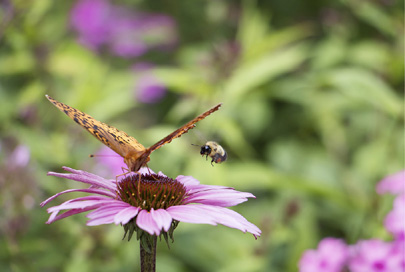
Coneflowers attract many different pollinators.

A glorious display of several different coneflowers and black-eyed Susans (Rudbeckia fulgida var. sullivantii ‘Goldsturm’) mingle to create substantial drifts between the daylilies; a few rogue beebalms (Monarda) lighten the moment.
Shadier areas benefit from the addition of bleeding heart (Lamprocapnos spectabilis) and other spring ephemerals for early season interest. Gold Heart (L. spectabilis ‘Gold Heart’) is a favorite of Anita’s, known for its golden leaves and pink heart-shaped flowers that dangle from the arched stems. With adequate water and afternoon shade, this foliage can persist through summer.
Finally, even with such careful attention to extending seasons of interest, a collector’s garden runs the risk of being predictable. Mike and Anita have added the element of surprise while also interjecting their humor and personalities. Decorative garden art is tucked discreetly into the garden, and an assortment of birdfeeders and birdhouses keep feathered friends visiting on a regular basis.
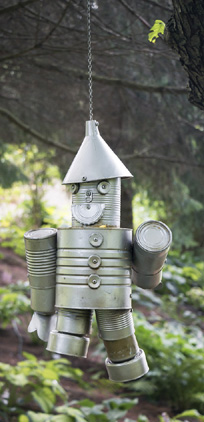
A tin-can tin man always elicits a smile.

Tucked into the branches of a sheltering maple, a rustic birdhouse hosts another season of inhabitants.
Top 10 Plants
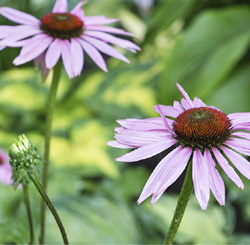
Ruby Giant purple coneflower (Echinacea purpurea ‘Ruby Giant’). This easily grown perennial is noted for its oversized daisy flowers, with ruby-pink petals and orange-brown central cone. Makes an excellent cut flower, attracts pollinators, and has a long bloom time, from summer until fall. Grows 2.5 feet tall, 1.5 feet wide. Full sun, zones 3–9. Deer resistance: B.
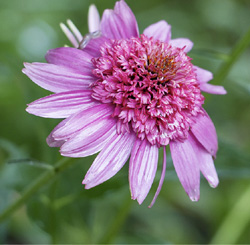
Gum Drop purple coneflower (Echinacea purpurea ‘Gum Drop’). Feathery pom-pom flowers are the hallmark of this cultivar. Deep pink double flowers stand tall on stout stems; at 2.5 feet tall and 1.5 feet wide, this is an ideal candidate for the middle of the border. Full sun, zones 4–9. Deer resistance: B.
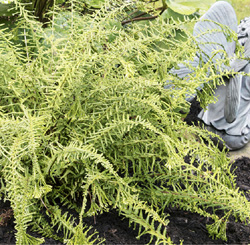
Victorian lady fern (Athyrium filix-femina ‘Cruciato-cristatum’). The original parent fern was discovered in England in the 1860s and presented to Queen Victoria as a gift. Seedlings vary enormously in size and structure but typically are 1–3 feet tall and wide and display an intricate lattice-like detail. These ferns do best with evenly moist soil and protection from strong winds. Partial shade–full shade, zones 4–8. Deer resistance: A.
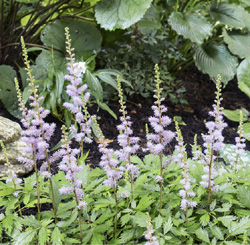
Dwarf Chinese astilbe (Astilbe chinensis var. pumila). Thick stiff panicles of lavender-pink flowers appear above the mounding green foliage in summer. This spreading, herbaceous perennial, 1 foot tall and wide, thrives with even soil moisture; it has better sun tolerance than other astilbes but looks its best in partial shade. Partial shade–full shade, zones 4–8. Deer resistance: B.
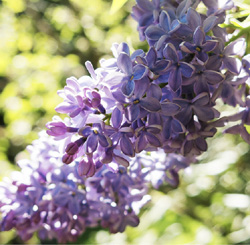
President Lincoln lilac (Syringa vulgaris ‘President Lincoln’). An outstanding variety of a beloved multi-stemmed deciduous shrub, 10 feet tall and 6 feet wide, known for its large trusses of sweetly fragrant, single Wedgwood-blue flowers that perfume the air in spring. As a hedge component, it provides seasonal screening. Full sun–partial sun, zones 3–8. Deer resistance: B.
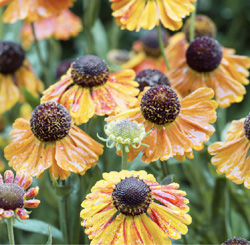
Sneezeweed (Helenium). The identity of this variety, received as a gift, is not known, but Mardi Gras or Moerheim Beauty are similar in color and habit, the former being a little shorter. Sneezeweed is a spreading, herbaceous perennial that is easy to grow, to 5 feet tall, 3 feet wide. The colorful blooms make excellent cut flowers and attract pollinators. Full sun–partial sun, zones 3–8. Deer resistance: B.
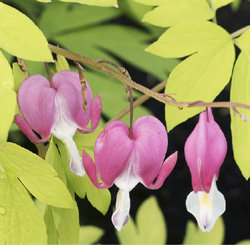
Gold Heart bleeding heart (Lamprocapnos spectabilis ‘Gold Heart’). With golden fern-like foliage and arching branches of dangling pink flowers, this is a colorful perennial for the shade garden. The foliage typically dies back by midsummer but may persist into fall with regular watering. Grows 2 feet tall, 3 feet wide. Partial shade–full shade, zones 3–9. Deer resistance: A.
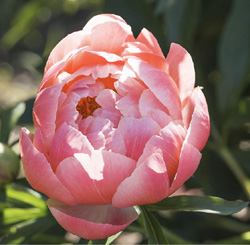
Coral Charm peony (Paeonia ‘Coral Charm’). Deep coral buds open into large, bowl-shaped, semi-double flowers in a softer coral-peach, fading gradually to ivory; the deep green foliage is attractive through fall. An excellent cut flower with a light fragrance. Grows 3 feet tall and wide. Full sun–partial sun, zones 4–8. Deer resistance: A.
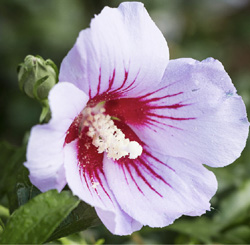
Orchid Satin rose of Sharon (Hibiscus syriacus ‘Orchid Satin’). Large orchid-pink blooms, each with a deep red eye, appear in great profusion along the gracefully arching branches of this deciduous shrub, 8–12 feet tall, up to 6 feet wide. This variety does not set seed and therefore lacks the invasive tendencies of some older forms. Full sun, zones 5–9. Deer resistance: B.
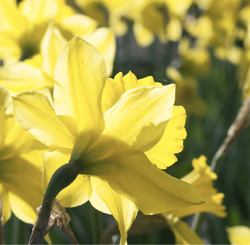
Daffodil (Narcissus). Thriving in organically rich, well-drained soil, these iconic spring-blooming bulbous perennials may naturalize in the garden. Many flower types, colors, and sizes are available; plants are 0.5–2.5 feet tall and up to 1 foot wide. Full sun–partial sun, zones 4–8. Deer resistance: A.